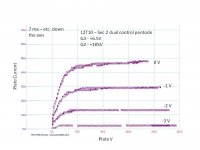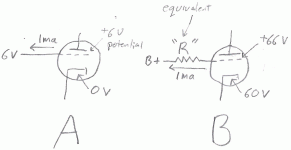Here are the curves for a 12T10 sec 2, with G3 elevated to 6.5V (4 old D cell batteries, used what I had...). Looks really good. Now I need to go back and rework things. Somehow I think I may actually end up building a half-way decent amp out of all of this.
The graph is kind of raggedy because I'm pushing the limits of my digital scope. It has 8 bits per channel, and the current is measured by drop across a 10K resistor on the plate by measuring the voltage on both ends. 200V give or take at each end takes the 8 bits. About 50V across the resistor, which gives 6 bits for the current, or about 1.5% resolution. This is the best it will do, but good enough for government work.
The graph is kind of raggedy because I'm pushing the limits of my digital scope. It has 8 bits per channel, and the current is measured by drop across a 10K resistor on the plate by measuring the voltage on both ends. 200V give or take at each end takes the 8 bits. About 50V across the resistor, which gives 6 bits for the current, or about 1.5% resolution. This is the best it will do, but good enough for government work.
Attachments
Something has been bothering me about my plan, I've attached a diagram that attempts to explain it.
Case "A" is as I tested it, case "B" is as I intend to use it in a LTP. In case B the "R" is intended to stand-in for whatever circuit actually sets the voltage.
In case "B" ~10X the power is being dissipated by G3, right? Or am I missing something.
Thanks...
Case "A" is as I tested it, case "B" is as I intend to use it in a LTP. In case B the "R" is intended to stand-in for whatever circuit actually sets the voltage.
In case "B" ~10X the power is being dissipated by G3, right? Or am I missing something.
Thanks...
Attachments
Should be the same actual dissipation by G3, the other 60 V drop below the cathode will be dissipating the remaining 10X (ie, an extra milliamp across it).
Dooh! I should draw better schematics before I think about this sort of thing. I see it now, The tail resistor, the cathode resistor, the cathode iself, G3, and whatever is between G3 and the voltage source dissipate power the same way as a string of resistors does.
This is what comes of spending too many years doing only "digital" electronic projects, I've forgotten how to think in analog...
This is what comes of spending too many years doing only "digital" electronic projects, I've forgotten how to think in analog...
It just occurred to me that a tube suffering secondary emission might be a case where Ohms Laws don't quite apply correctly.
An energetic electron could bounce off the plate as secondary emission, but deposit most of its energy as heat there. While actually getting absorbed by say the screen grid and flowing out there. Tallying up the voltages and currents on the different electrodes would not come up correctly to Watts = V*I, although I'm sure the total energy gets conserved, or we would be doing more of this "cheating".
An energetic electron could bounce off the plate as secondary emission, but deposit most of its energy as heat there. While actually getting absorbed by say the screen grid and flowing out there. Tallying up the voltages and currents on the different electrodes would not come up correctly to Watts = V*I, although I'm sure the total energy gets conserved, or we would be doing more of this "cheating".
I've learned one important thing over the last evening. The properties of G3 vary widely between tubes of at least two manufacturers: RCA and GE (who also apparently made "Realistic" tubes by the appearance). Can't use a simple voltage divider without dropping a lot of current through it, since the amount G3 pulls (pushes? 🙂 is very different between the two manufacturers. Otherwise the tubes behave the same way. I suppose since using it this way is "out of spec" it wasn't something measured or designed to.
For my design the voltage needed will come out to around 80V or so, so I guess I could keep it "pure tube" with a gas-filled regulator. Or just cave in and use a zener....
For my design the voltage needed will come out to around 80V or so, so I guess I could keep it "pure tube" with a gas-filled regulator. Or just cave in and use a zener....
Im jumping on this thread following smoking-amp's suggestion of my GF building an amp with 12 of these little chaps.
She is likely to build one "off the shelf kit" but im fascinated by the idea of a dozen of these "press ganged" into audio service glowing away like a well planted vegetable patch of little tubes.
Has anyone come up with a circuit diagram I can start off building this thing from? Soldering components and testing with a scope is within my capabilities but designing circuits is well out of my capability level.
She is likely to build one "off the shelf kit" but im fascinated by the idea of a dozen of these "press ganged" into audio service glowing away like a well planted vegetable patch of little tubes.
Has anyone come up with a circuit diagram I can start off building this thing from? Soldering components and testing with a scope is within my capabilities but designing circuits is well out of my capability level.
I think that was referring to the 12HL7, a high gm pentode. But both the 12HL7 and the 12T10 mentioned above are on the $1 list here:
Summer Dollar Days - Vacuum Tube Sale - $1.00 Vacuum Tubes
For a low voltage amp though, your best bet would be to use the 12HL7 as the differential input stage, and some 26DQ5 for the outputs. Those are $3 from the same source, ESRC. But a bunch of 12HL7s in parallel could obviously work too. They are frame grid, so I would put a couple of series SS diodes across the cathode to grid1 to limit positive excursions.
The 12T10 has a high knee voltage that would not go with a LV amp well.
http://frank.pocnet.net/sheets/135/1/12HL7.pdf
http://frank.pocnet.net/sheets/106/6/6DQ5.pdf
http://frank.pocnet.net/sheets/123/6/6T10.pdf
Summer Dollar Days - Vacuum Tube Sale - $1.00 Vacuum Tubes
For a low voltage amp though, your best bet would be to use the 12HL7 as the differential input stage, and some 26DQ5 for the outputs. Those are $3 from the same source, ESRC. But a bunch of 12HL7s in parallel could obviously work too. They are frame grid, so I would put a couple of series SS diodes across the cathode to grid1 to limit positive excursions.
The 12T10 has a high knee voltage that would not go with a LV amp well.
http://frank.pocnet.net/sheets/135/1/12HL7.pdf
http://frank.pocnet.net/sheets/106/6/6DQ5.pdf
http://frank.pocnet.net/sheets/123/6/6T10.pdf
P=VI is not Ohm's Law (that is V=IR). Ohm's Law is not a law of nature so it doesn't matter if it gets 'violated'; it simply says that for many conductors it turns out that current and voltage are proportional.smoking-amp said:It just occurred to me that a tube suffering secondary emission might be a case where Ohms Laws don't quite apply correctly.
An energetic electron could bounce off the plate as secondary emission, but deposit most of its energy as heat there. While actually getting absorbed by say the screen grid and flowing out there. Tallying up the voltages and currents on the different electrodes would not come up correctly to Watts = V*I, although I'm sure the total energy gets conserved, or we would be doing more of this "cheating".
P=VI is a law of nature, in the sense that if you have simple geometry it will be true. For more complex situations you have to use the Poynting Conjecture, which enables you to calculate the total energy flow into a closed surface from knowledge of the fields on the boundary. Energy is conserved, but the heat in an electrode might not arise simply from the current flow to that electrode.
Taking the simple case where there is one secondary electron for each primary electron, you would get zero anode current but still some anode dissipation. The total energy would come from Vg2 x Ig2, even though some of this would heat the anode instead of the screen.
I don't use GU-50 without +12V on the 3'Rd grid. And 4P1L is a nice triode when 2 grids are connected to anode.
I have been reading your stuff for years . . . I haven't understood much of it, but I sure have enjoyed trying.Member Pete Millett published an amplifier design in the AudioXpress magazine recently. It used a dual control pentode with positive bias applied to G3. The article can be found here:
http://www.audioxpress.com/magsdirx/ax/addenda/media/millet2903.pdf
Do you have a link where I can buy you a cup of coffee (or two)? I really do appreciate the quantity and quality of your comments over the years.
Hope all is well in WV (or wherever you are today).
Yes, I know this in an old thread - it reminded me of an interesting note here https://www.radiomuseum.org/tubes/tube_12hl7.html on the effect on 12HL7 plate curves as g3 potential is varied.I think that was referring to the 12HL7, a high gm pentode.
- Home
- Amplifiers
- Tubes / Valves
- a better pentode for less!

